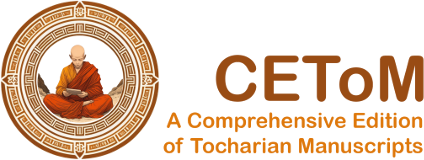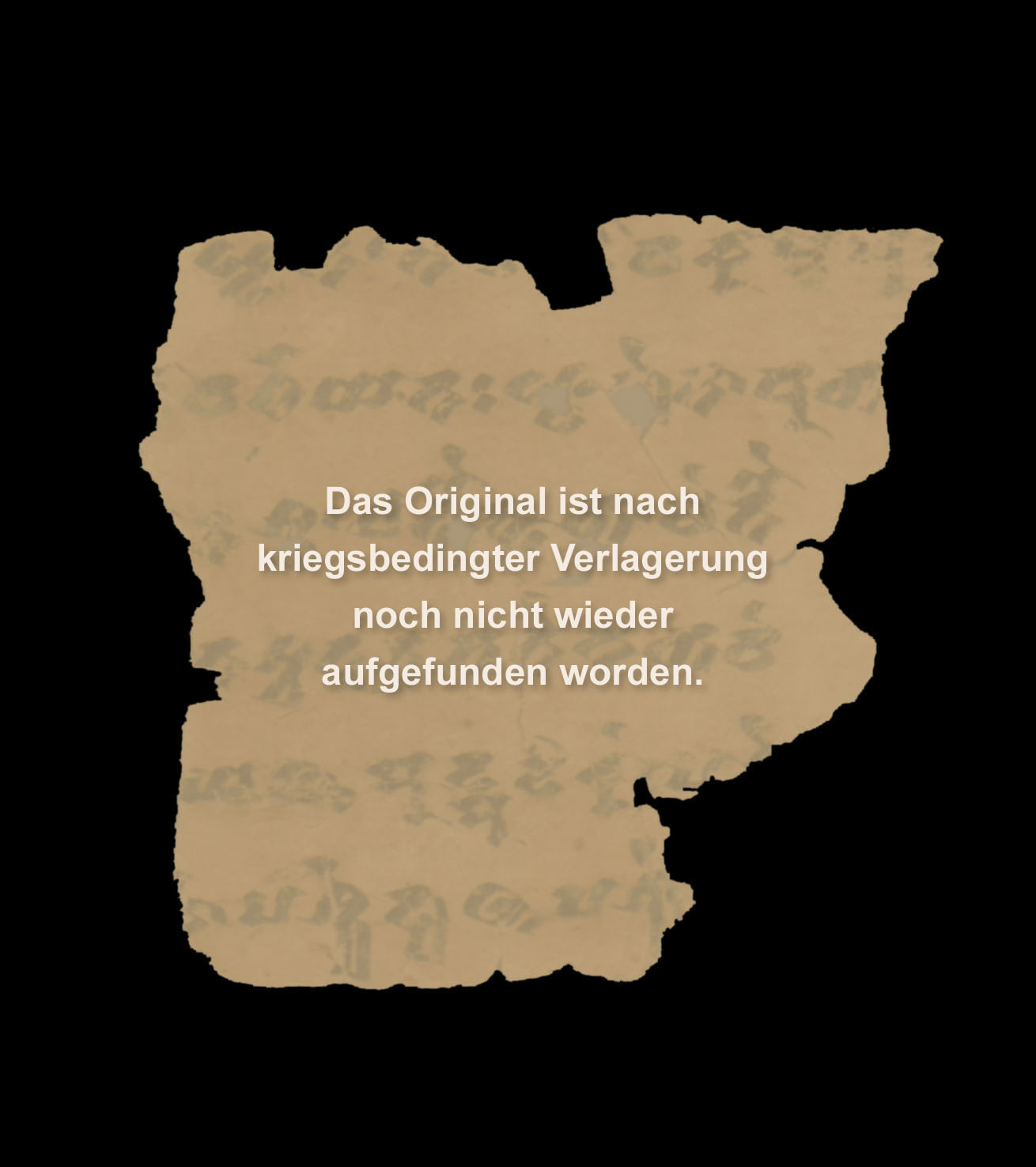THT 53
| Known as: | THT 53; B 53 |
|---|---|
| Cite this page as: | Hannes A. Fellner. "THT 53". In A Comprehensive Edition of Tocharian Manuscripts (CEToM). Created and maintained by Melanie Malzahn, Martin Braun, Hannes A. Fellner, and Bernhard Koller. https://cetom.univie.ac.at/?m-tht53 (accessed 01 Jul. 2025). |
Edition | |
| Editor: | Hannes A. Fellner |
Provenience | |
| Main find spot: | Shorchuk |
| Expedition code: | T III Š 64, T III Š 90 Frgm |
| Collection: | Berlin Turfan Collection |
Language and Script | |
| Language: | TB |
| Linguistic stage: | classical |
| Script: | classical |
Text contents | |
| Title of the work: | Udānālaṅkāra |
| Passage: | uncertain |
| Text genre: | Literary |
| Text subgenre: | Doctrine |
| Verse/Prose: | verse |
Object | |
| Manuscript: | Udānālaṅkāra A |
| Material: | ink on paper |
| Form: | Poṭhī |
| Number of lines: | 3 |
Images
Images from idp.bl.uk by courtesy of the International Dunhuang Project, the Berlin-Brandenburgische Akademie der Wissenschaften, and the Staatsbibliothek zu Berlin – Orientabteilung.
Transliteration
| a1 | /// se mpe lye c[au] pru śya – – – w· [k]· /// |
|---|---|
| a2 | /// 50 4 sa swa [p]st[i] nā ṣṣa rpi mcu ṣka ntā /// |
| a3 | /// [y]o [pa] r·e r·e ·e ·[ai] – ña ·eṃ [l]· ·[i] /// |
| b1 | /// |
| b2 | /// ·t[e] ki ññai [wa] [t]po tre meṃ tsṣa rmtsa : kuse tne /// |
| b3 | /// [a] knā tsa : ṣka [s]ka śtwā – ·e – ya ma s[t]· ā /// |
Transcription
| 54d | a1/// s= empelye cau pruśya – – – w· k· /// a2/// 50-4 |
|---|---|
| Xx | saswa pstināṣṣar pi ; mcuṣkant= ā /// a3/// yopar ·er ·e ·e ·ai – ña ·eṃ l· ·i /// b1/// b2/// · tekiññai wat ; po tremeṃts ṣarmtsa : |
| Xx | kuse tne /// b3/// aknātsa : |
| * | ṣkaska śtwā(ra) ·e ·– yamast(r)= ā /// |
|---|
Translation
| a1 | ... horrible these he neglected ... |
|---|---|
| a2 | ... O lord, let them be silent, the princes ... |
| a3 | ... |
| b2 | ... or a sick one, all because of the anger ... who now ... |
| b3 | ... fool ... sixty-four ... he does ... |
Other
| a2 | Lord, please make the princes [keep] silent! (Peyrot 2013b: 361) |
|---|
Commentary
Philological commentary
| Here, too, there is only one single strophe number and uncertainty concerning the recto and verso side. The metre appears to be 4x17 syllables (rhythm = 6/6/5). |
Remarks
| The original manuscript is missing, but was a fragment composed of two smaller pieces, damaged on all sides and containing remnants of three lines only. |
References
Online access
Edition
Sieg and Siegling 1949: I, 74; Sieg and Siegling 1983: 89 notes 224
Translations
Krause 1952: a1 (153); Peyrot 2013b: a2 (361); Thomas 1957: a1 (22)
Bibliography
“The International Dunhuang Project: The Silk Road Online.” n.d. http://idp.bl.uk.
Krause, Wolfgang. 1952. Westtocharische Grammatik, Band I. Das Verbum. Heidelberg: Winter.
Peyrot, Michaël. 2013b. The Tocharian subjunctive. A study in syntax and verbal stem formation. Vol. 8. Brill’s Studies in Indo-European Languages & Linguistics. Leiden/Boston: Brill.
Sieg, Emil, and Wilhelm Siegling. 1949. Tocharische Sprachreste. Sprache B, Heft 1. Die Udānālaṅkāra-Fragmente. Text, Übersetzung und Glossar. Göttingen: Vandenhoeck & Ruprecht.
Sieg, Emil, and Wilhelm Siegling. 1983. Tocharische Sprachreste. Sprache B. Teil I: Die Texte. Band 1. Fragmente Nr. 1-116 der Berliner Sammlung. Edited by Werner Thomas. Neubearbeitet und mit einem Kommentar nebst Register versehen v. Werner Thomas. Göttingen: Vandenhoeck & Ruprecht.
Thomas, Werner. 1957. Der Gebrauch der Vergangenheitstempora im Tocharischen. Wiesbaden: Harrassowitz.
Gippert, Jost, Katharina Kupfer, Christiane Schaefer, and Tatsushi Tamai. n.d. “Thesaurus Indogermanischer Text- und Sprachmaterialien (TITUS): Tocharian Manuscripts from the Berlin Turfan Collection.” http://titus.fkidg1.uni-frankfurt.de/texte/tocharic/thtframe.htm.



